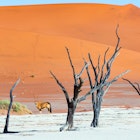
The best times to visit Namibia for hiking, wildlife and more

Oct 23, 2023 тЂ 4 min read

Take advantage of Namibia's dry skies for excellent stargazing ТЉ Paul & Paveena Mckenzie / Getty Images
With its famously clear skies and abundant sunshine, Namibia is a wonderful destination at any time of year. The weather is almost always good т the ever-present sunshine is even highlighted on the national flag т and most areas of the country are accessible year-round.
Yet, depending on your interests, itтs worth putting some thought into the timing of your trip. Hiking is best planned for the cooler winter months from May to October to avoid the summertime heat, while coastal exploration is easier in the summer, from December to March, when winds are gentler and there is less fog.
Whatever draws you, plan the perfect time for your visit with this guide to Namibiaтs seasons and events.

June to October is the best time for safaris and for visiting Sossusvlei
Cloudless daytime skies, clear, cold nights and almost no likelihood of rain are the hallmarks of Namibiaтs wintertime, from June to October. Inland, temperatures average between 19ТКC and 24ТКC (66ТКF to 75ТКF) during the day, while from June to August, nighttime temperatures in the desert and at altitude generally sit below 10ТКC (50ТКF) and sometimes drop below freezing.
The cooler high season is also the dry season, so foliage is less dense and animals can be easily spotted as they congregate around scarce water sources. This is a fine time of year for wildlife watching at Etosha National Park, and safari camps fill up. On the coast, winds can be stiff and the shoreline is often blanketed by a thick morning fog, although this generally burns off before midday.
If you're thinking of scaling the dunes around Sossusvlei, June through August are ideal months, as temperatures are at their coolest and the sands not as searingly hot.
In delightful October, with winter definitively over, Namibia's jacaranda trees burst into bloom. They are especially lovely in Windhoek and the northern town of Tsumeb, where streets are shaded by lavender-hued canopies and carpeted with the fallen blossoms.

April, May and November are best for shoulder-season discounts and exploring away from the crowds
April and May are lovely times to be in Namibia. Much of the country is covered in shades of vivid green, the rains have washed away the late dry-season dust and the air is exceptionally clear. Daytime temperatures range from 24ТКC to 28ТКC (75ТКF to 82ТКF). Apart from the Easter holidays, safari camps are generally not full.
In November, daytime temperatures can exceed 30ТКC (86ТКF) as the thirsty land eagerly awaits the return of the rains. Wildlife watching is ideal, with plenty of animals visible, but without the crowds of July and August. Many lodges and camps in national parks and private reserves offer discounted rates. Birding also starts to peak at this time, as migrant species make their way into the region.

December to March is the best time for coastal travel and birding
Along the coast, the Namibian summer is marked by a holiday vibe, pleasant conditions and opportunities galore for a braai (barbeque). Sea breezes provide refreshing relief from the inland heat, and there is less fog and wind than in the winter months.
With the advent of the rains, birding in Etosha National Park and countrywide reaches its prime. Around February, flamingos gather by the thousands in Etosha pan to breed т a magnificent sight. While Etoshaтs wildlife is widely dispersed and can be difficult to spot, the park has its own appeal at this time, with no crowds apart from the Christmas-New Year period.
Although the summer months are the wettest time of year in Namibia, downpours are mostly limited to late afternoons and evenings. Unpaved roads, especially in the far north and in the waterway-laced Zambezi region, can become difficult to traverse, but otherwise, rain does not usually interfere with travel.
Temperatures are high everywhere, especially in the far south. In the Fish River Canyon, the mercury can soar to above 40ТКC (104ТКF), and the canyon hiking trail is closed.
Namibian Independence Day on 21 March heralds the end of summer, as the skies clear and migrant birds prepare to depart.
Wherever you travel, keep in mind that accommodation - especially on the coast and in Etosha National Park - fills up during the December and January school holidays; advance bookings are recommended.
Explore related stories



 Art and Culture7 of 2024's best TV and movie locations to inspire your travels
Art and Culture7 of 2024's best TV and movie locations to inspire your travelsJul 18, 2024 тЂ 7 min read



 Destination PracticalitiesI want to go on a safari in Botswana, Kenya or Tanzania - how hard would it be to drive myself?
Destination PracticalitiesI want to go on a safari in Botswana, Kenya or Tanzania - how hard would it be to drive myself?Dec 8, 2023 тЂ 4 min read


